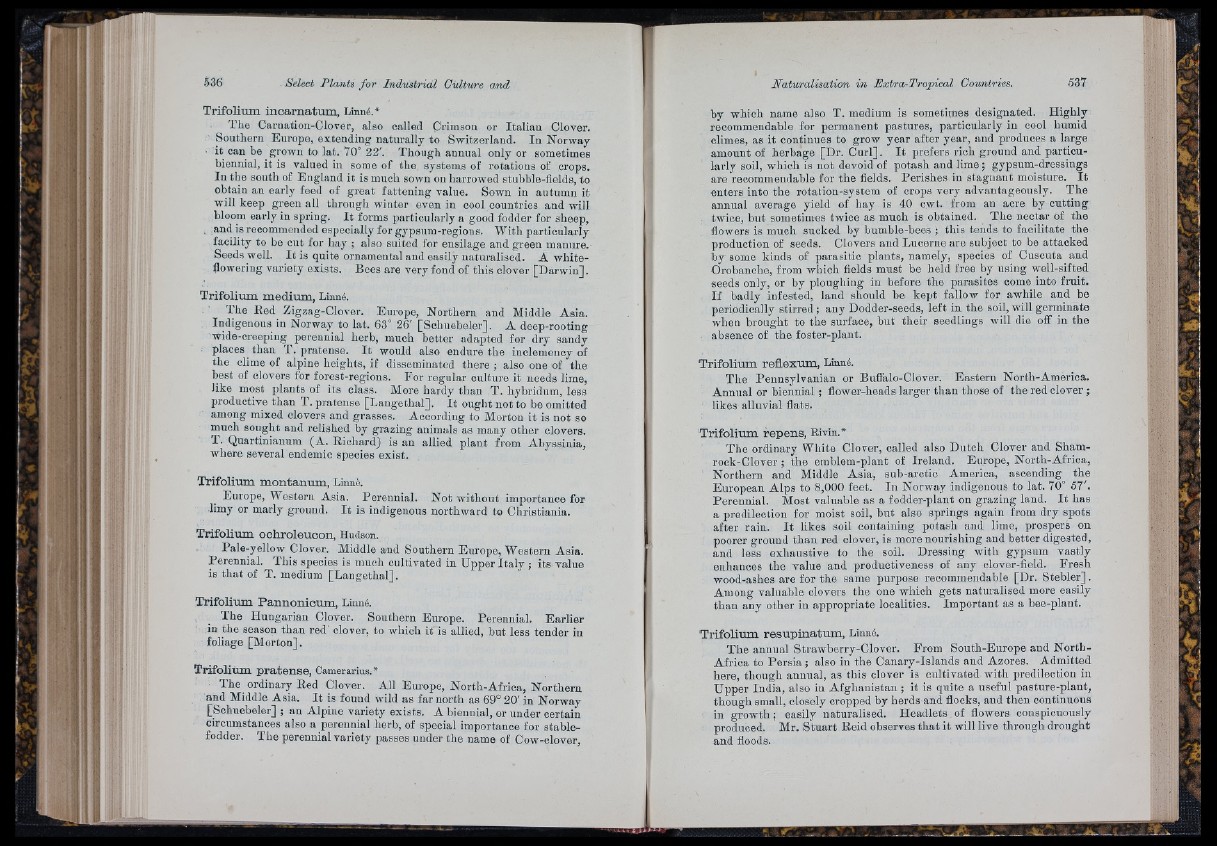
Trifolium incarnatum, Linné.*
The Carnatioii-Clover, also called Crimson or Italian Clover.
Southern Europe, extending naturally to Switzerland. In Norway
■ it can he grown to lat. 70° 22'. Though annual only or sometimes
biennial, it is valued in some of the systems of rotations of crops.
In the south of England it is much sown on harrowed stubble-fields, to
obtain an early feed of great fattening valne. Sown in autumn it
will keep green all through winter even in cool countries and will
bloom early in spring. I t forms particularly a good fodder for sheep,
, and is recommended especially for gypsum-regions. With particularly
facility to be cut for hay ; also suited for ensilage and green manure.
Seeds well. I t is quite ornamental and easily naturalised. A white-
flowering variety exists. Bees are very fond of this clover [D arw in ].
Trifolium medium, Linné.
The Red Zigzag-Clover. Europe, Northern and Middle Asia.
Indigenous in Norway to lat. 63° 26' [Schuebeler], A deep-rooting
wide-creeping perennial herb, much better adapted for dry sandy
places ^ than T. pratense. I t would also endure the inclemency of
the clime of alpine heights, if disseminated there ; also one of the
best of clovers for forest-regions. For regular culture it needs lime,
like most plants of its class. More hardy than T. hybridum, less
productive than T. pratense [Langethal]. I t o u g litn o tto be omitted
among mixed clovers aud grasses. According to Morton it is not so
much sought and relished by grazing animals as many other clovers.
T. Quartiniauum (A. Richard) is an allied plant from Abyssinia,
where several endemic species exist.
Trifolium montamun, Linné.
Europe, Western Asia. Perennial. Not without importance for
limy or marly ground. I t is indigenous northward to Christiania.
Trifolium ochroleucon, Hudson.
Pale-yellow Clover. Middle and Southern Europe, Western Asia.
Perennial. This species is much cultivated in Upper Ita ly ; its value
is th a t of T. medium [Langethal].
Trifolium Pannonicum, Linné.
The Hungarian Clover. Southern Europe. Perennial. Earlier
in the season than red' clover, to which it is allied, but less tender in
foliage [Morton].
Trifolium pratense, Camerarius.*
The ordinary Red Clover. All Europe, North-Africa, Northern
and Middle Asia. I t is found wild as far north as 69° 20' in Norway
[Sohuebeler] ; an Alpine variety exists. A biennial, or under certain
circumstances also a perennial herb, of special importance for stable-
fodder. The perennial variety passes under the name of Cow-clover,
by which name also T. medium is sometimes designated. Highly
reeommendable for permanent pastures, partioularly in cool humid
climes, as it continues to grow year after year, and produces a large
amount of herbage [Dr. Curl], I t prefers rich ground and particularly
soil, which is not devoid of potash and lime ; gypsum-dressings
are reeommendable for the fields. Perishes in stagnant moisture. I t
enters into the rotation-system of crops very advantageously. The
annual average yield of hay is 40 cwt. from an acre by cutting
twice, but sometimes twice as muoli is obtained. The nectar of the
flowers is much sucked by bumble-bees ; this tends to facilitate the
production of seeds. Clovers and Lucerne are subject to be attacked
by some kinds of parasitic plants, namely, species of Cuscnta and
Orobanche, from which fields must be held free by using well-sifted
seeds only, or by ploughing in before the parasites come into fruit.
I f badly infested, land should be kept fallow for awhile and be
periodically stirred; any Dodder-seeds, left in the soil, will germinate
when brought to the surface, but their seedlings will die off in the
absence of the foster-plant.
Trifolium refiexum, Linné.
The Pennsylvanian or Buffalo-Clover. Eastern North-Amerioa.
Annual or biennial ; flower-heads larger than those of the red clover ;
likes alluvial flats.
Trifolium repens, Rivin.*
Tlie ordinary White Clover, called also Dutch Clover and Sham-
rock-Clover ; the emblem-plant of Ireland. Europe, North-Africa,
Northern and Middle Asia, sub-arctic America, ascending the
European Alps to 8,000 feet. In Norway indigenous to lat. 70° 57'.
Perennial. Most valnable as a fodder-plant on grazing land. I t has
a predilection for moist soil, hut also springs again from dry spots
after rain. I t likes soil containing potash and lime, prospers on
poorer ground than red clover, is more nourishing and better digested,
and less exhaustive to the soil. Dressing with gypsum vastly
enhances the value and productiveness of any clover-field. Fresh
wood-ashes are for the same purpose reeommendable [Dr. S teb le r].
Among valuable clovers the one which gets naturalised more easily
than any other in appropriate localities. Important as a bee-plant.
Trifolium resupinatum, Linné.
The annual Strawberry-Clover. From South-Europe aud North-
Africa to Persia ; also in the Canary-Islands and Azores. Admitted
here, though annual, as this clover is cultivated with predilection in
Upper India, also iu Afghanistan ; it is quite a useful pasture-plant,
though small, closely cropped by herds and flocks, and then continuous
in growth ; easily naturalised. Headlets of flowers conspicuously
produced. Mr. Stuart Reid observes th a t it will live through drought
and floods.